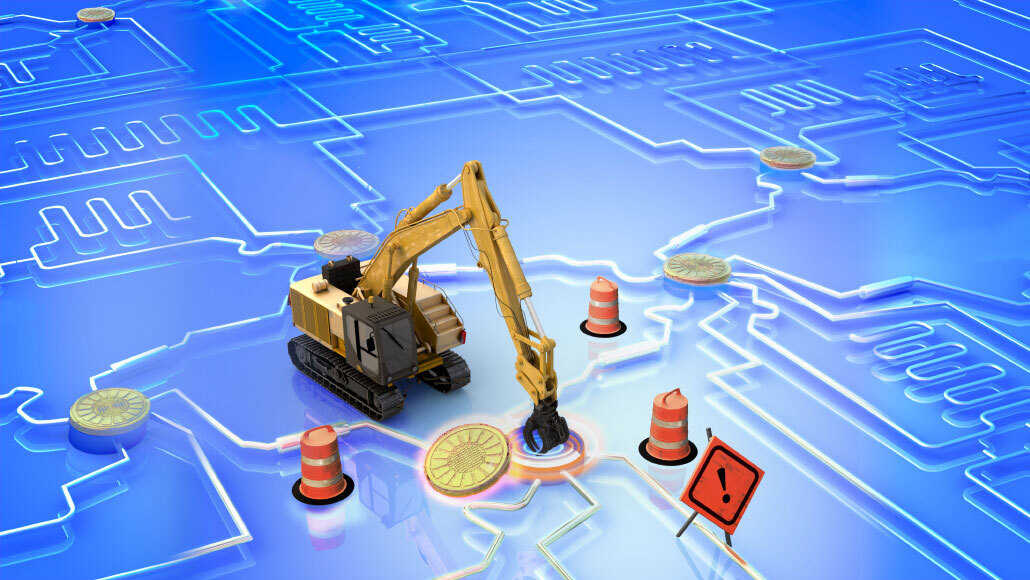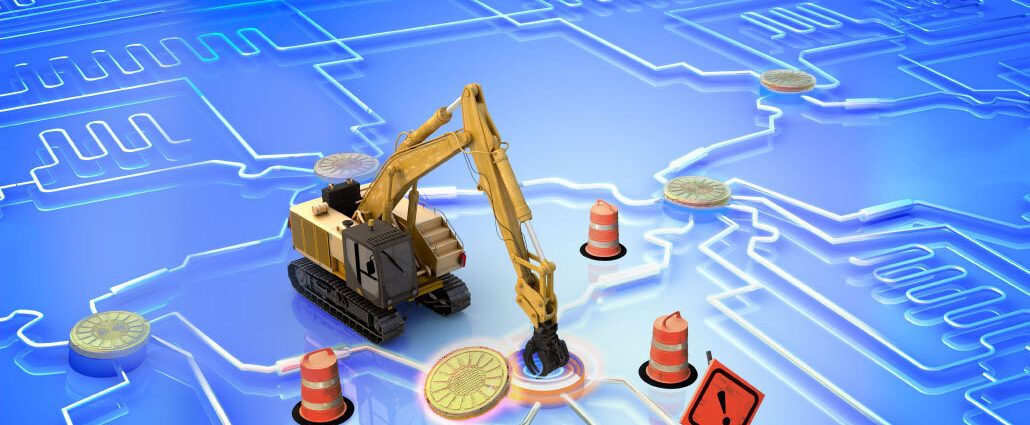The devices will reach their potential only if they can fix their glitches

Physicists try to construct ways to find and correct errors in quantum computers without wrecking the data.
Astronaut John Glenn was wary about trusting a computer.
It was 1962, early in the computer age, and a room-sized machine had calculated the flight path for his upcoming orbit of Earth — the first for an American. But Glenn wasn’t willing to entrust his life to a newfangled machine that might make a mistake.
The astronaut requested that mathematician Katherine Johnson double-check the computer’s numbers, as recounted in the book Hidden Figures. “If she says they’re good,” Glenn reportedly said, “then I’m ready to go.” Johnson determined that the computer, an IBM 7090, was correct, and Glenn’s voyage became a celebrated milestone of spaceflight (SN: 3/3/62, p. 131).
A computer that is even slightly error-prone can doom a calculation. Imagine a computer with 99 percent accuracy. Most of the time the computer tells you 1+1=2. But once every 100 calculations, it flubs: 1+1=3. Now, multiply that error rate by the billions or trillions of calculations per second possible in a typical modern computer. For complex computations, a small probability for error can quickly generate a nonsense answer. If NASA had been relying on a computer that glitchy, Glenn would have been right to be anxious.
Luckily, modern computers are very reliable. But the era of a new breed of powerful calculator is dawning. Scientists expect quantum computers to one day solve problems vastly too complex for standard computers (SN: 7/8/17, p. 28).
Current versions are relatively wimpy, but with improvements, quantum computers have the potential to search enormous databases at lightning speed, or quickly factor huge numbers that would take a normal computer longer than the age of the universe. The machines could calculate the properties of intricate molecules or unlock the secrets of complicated chemical reactions. That kind of power could speed up the discovery of lifesaving drugs or help slash energy requirements for intensive industrial processes such as fertilizer production.
But there’s a catch: Unlike today’s reliable conventional computers, quantum computers must grapple with major error woes. And the quantum calculations scientists envision are complex enough to be impossible to redo by hand, as Johnson did for Glenn’s ambitious flight.
If errors aren’t brought under control, scientists’ high hopes for quantum computers could come crashing down to Earth.
Fragile qubits
Conventional computers — which physicists call classical computers to distinguish them from the quantum variety — are resistant to errors. In a classical hard drive, for example, the data are stored in bits, 0s or 1s that are represented by magnetized regions consisting of many atoms. That large group of atoms offers a built-in redundancy that makes classical bits resilient. Jostling one of the bit’s atoms won’t change the overall magnetization of the bit and its corresponding value of 0 or 1.
But quantum bits — or qubits — are inherently fragile. They are made from sensitive substances such as individual atoms, electrons trapped within tiny chunks of silicon called quantum dots, or small bits of superconducting material, which conducts electricity without resistance. Errors can creep in as qubits interact with their environment, potentially including electromagnetic fields, heat or stray atoms or molecules. If a single atom that represents a qubit gets jostled, the information the qubit was storing is lost.
Additionally, each step of a calculation has a significant chance of introducing error. As a result, for complex calculations, “the output will be garbage,” says quantum physicist Barbara Terhal of the research center QuTech in Delft, Netherlands.
Before quantum computers can reach their much-hyped potential, scientists will need to master new tactics for fixing errors, an area of research called quantum error correction. The idea behind many of these schemes is to combine multiple error-prone qubits to form one more reliable qubit. The technique battles what seems to be a natural tendency of the universe — quantum things eventually lose their quantumness through interactions with their surroundings, a relentless process known as decoherence.
“It’s like fighting erosion,” says Ken Brown, a quantum engineer at Duke University. But quantum error correction provides a way to control the seemingly uncontrollable.
Make no mistake
Quantum computers gain their power from the special rules that govern qubits. Unlike classical bits, which have a value of either 0 or 1, qubits can take on an intermediate state called a superposition, meaning they hold a value of 0 and 1 at the same time. Additionally, two qubits can be entangled, with their values linked as if they are one entity, despite sitting on opposite ends of a computer chip.
These unusual properties give quantum computers their game-changing method of calculation. Different possible solutions to a problem can be considered simultaneously, with the wrong answers canceling one another out and the right one being amplified. That allows the computer to quickly converge on the correct solution without needing to check each possibility individually.
The concept of quantum computers began gaining steam in the 1990s, when MIT mathematician Peter Shor, then at AT&T Bell Laboratories in Murray Hill, N.J., discovered that quantum computers could quickly factor large numbers (SN Online: 4/10/14). That was a scary prospect for computer security experts, because the fact that such a task is difficult is essential to the way computers encrypt sensitive information. Suddenly, scientists urgently needed to know if quantum computers could become reality.
Shor’s idea was theoretical; no one had demonstrated that it could be done in practice. Qubits might be too temperamental for quantum computers to ever gain the upper hand. “It may be that the whole difference in the computational power depends on this extreme accuracy, and if you don’t have this extreme accuracy, then this computational power disappears,” says theoretical computer scientist Dorit Aharonov of Hebrew University of Jerusalem.
But soon, scientists began coming up with error-correction schemes that theoretically could fix the mistakes that slip into quantum calculations and put quantum computers on more solid footing.
For classical computers, correcting errors, if they do occur, is straightforward. One simple scheme goes like this: If your bit is a 1, just copy that three times for 111. Likewise, 0 becomes 000. If one of those bits is accidentally flipped — say, 111 turns into 110, the three bits will no longer match, indicating an error. By taking the majority, you can determine which bit is wrong and fix it.
But for quantum computers, the picture is more complex, for several reasons. First, a principle of quantum mechanics called the no-cloning theorem says that it’s impossible to copy an arbitrary quantum state, so qubits can’t be duplicated.
Secondly, making measurements to check the values of qubits wipes their quantum properties. If a qubit is in a superposition of 0 and 1, measuring its value will destroy that superposition. It’s like opening the box that contains Schrödinger’s cat. This imaginary feline of quantum physics is famously both dead and alive when the box is closed, but opening it results in a cat that’s entirely dead or entirely alive, no longer in both states at once (SN: 6/25/16, p. 9).
So schemes for quantum error correction apply some work-arounds. Rather than making outright measurements of qubits to check for errors — opening the box on Schrödinger’s cat — scientists perform indirect measurements, which “measure what error occurred, but leave the actual information [that] you want to maintain untouched and unmeasured,” Aharonov says. For example, scientists can check if the values of two qubits agree with one another without measuring their values. It’s like checking whether two cats in boxes are in the same state of existence without determining whether they’re both alive or both dead.
And rather than directly copying qubits, error-correction schemes store data in a redundant way, with information spread over multiple entangled qubits, collectively known as a logical qubit. When individual qubits are combined in this way, the collective becomes more powerful than the sum of its parts. It’s a bit like a colony of ants. Each individual ant is relatively weak, but together, they create a vibrant superorganism.
Those logical qubits become the error-resistant qubits of the final computer. If your program requires 10 qubits to run, that means it needs 10 logical qubits — which could require a quantum computer with hundreds or even hundreds of thousands of the original, error-prone physical qubits. To run a really complex quantum computation, millions of physical qubits may be necessary — more plentiful than the ants that discovered a slice of last night’s pizza on the kitchen counter.
Creating that more powerful, superorganism-like qubit is the next big step in quantum error correction. Physicists have begun putting together some of the pieces needed, and hope for success in the next few years.





















